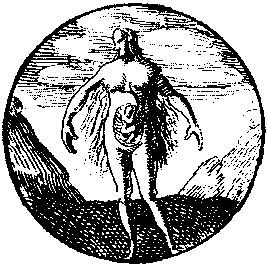|
The World of Teréth End - Spells & Magic |
||||||||||||||||||||||||||||||||||||||||||||||||||||||||||||
|
"22 Eren 583 DR. The conjurer Otora is dead. Our prayers led us unfailingly to her mountain lair. Many abominations assailed us. Our righteous strength prevailed against these vile creations. Her books and implements are burned. All is restored. Kandlan be praised." - Journal entry of Sir Tirus Cadar |
Book of Dragum Kreàd'a [way (conjure, create) (bear, gestate) (distill)] Dragum Kreàd'a, from a magical perspective,
is the most powerful of the magic arts. The magician that employs
this art gathers magical energy to create that which did not exist before.
This act of creation is accomplished through force of will over
energy, but sometimes employs existing matter. Creation is the process of bringing something into existence that does currently occur within the sphere. The First Law of Kreàd'a maintains that "No two objects may concurrently exist that are exactly the same". Because this is one of the few metaphysical "laws" of Teréth End, there are those who seek unendingly to disprove it. The quest to create a "true-twin object" is as hotly sought after as transforming things to gold (or mythrul). There are several stages of creation that the wizard must master before becoming a master conjurer. The first stage of Draga Creadra is suthuun, the ability to construct the proposed image of creation (phantarrum) within one's mind. This ability is not easy, and often requires years of meditative study. Having mastered suthuun, the caster is able to hold an image of a proposed creation in his mind with every detail of the object defined an rendered to perfection. If an object is created without this step, it quickly dissipates (after 1 second). If the step is skipped however, one second is dropped from the spell's casting time. The second stage of creation is iladth, the exertion of will upon the mind image to create the imagined form. Iladth has the effect of constructing the image of the form without substance. Iladth constructs essential objects in two forms, phantasm and illusion. Phantasms are those objects that appear only in the minds of the affected. Illusions are perceived by all who gaze on them. Iladth is the art that the faithful of Sudul excel in, though they don't view the creations as illusion so much as outerward dreaming. Followers of Sudul do not need to master suthuun as long as they maintain concentration on their creations. The tenets of Kandlan do not approve of illusions, though are more tolerant of them than physical creations. The third stage is vordis. Vordis calls upon surrounding energies or matter to give an essential image substance. It is in this stage that the essence of illusion is replaced with matter and becomes real. Creations subjected to vordis are not permanent. Permanence is granted through the exertion of further energies (see candarmin) which bind the substances in a lasting form. The last and most difficult stage of creation is candarmin, which grants the inanimate, life. Candarmin is the most complex step within the stages of creation and only achieved by the most committed conjurers. It is believed that the faithful of Kandlan can detect when this "veil" has been breached and do all in their power to stop it from doing further damage to their beloved cycle. Grimoire Infinitum Spells included here are not those owned or maintained by the sirkùli or cults but rather spells that have fallen into "outside" hands. Some of these spells have been so widely circulated that ownership is no longer known or recognized. Sirkùli spells may be found on the individual sirkùla pages. Cult spells can be found on the individual religion pages. D&D Spells:
GURPS Spells:
The Wizard's Bookshelf
|
Draga Orkid Dekàlan magics (Draga and Davra) are divided into 24 arts (see Draga Orkid). The magical Ways are: Ild'a
(to Control) The magical Forms are: Baras
(Animal) Additional 3E spells may be found in the: D20 Spell Indices Adept |
||||||||||||||||||||||||||||||||||||||||||||||||||||||||||
Ref. TG (Touched by the Gods), © Atlas Games; DL (Dragon
Lords of Melníboné), © Chaosium; S&S (Spells & Spellcraft),
© Fantasy Flight Games; MC:A (Master Class; Assassin's Handbook), MC:S (Master
Class: Shaman's Handbook), © Green Ronin Publishing; KKP (Kingdoms of Kalamar:
Player's Guide), KVH (Kingdoms of Kalamar: Villain Design Handbook), © Kenzer & Co.; EM (The Book of Eldritch Magic), ©
Malhavoc Press; WS (Wild Spellcraft), © Natural D20 Press; D&D (The Divine
& The Defeated), R&R (Relics & Rituals), © Sword & Sorcery
Studios; PHB (Player's Handbook), DF (Defenders of the Faith), Drag (Dragon Magazine),
FR (Forgotten Realms Campaign Setting), MF (Magic of Faerun), MW (Masters of the
Wild), SS (Song & Silence), TB (Tome & Blood), © Wizards of the Coast |
||||||||||||||||||||||||||||||||||||||||||||||||||||||||||||
 To
many, this is considered a god-like ability, too dangerous for the experimentations
of mortal men. In
To
many, this is considered a god-like ability, too dangerous for the experimentations
of mortal men. In